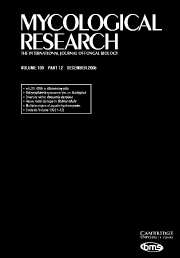Crossref Citations
This article has been cited by the following publications. This list is generated based on data provided by
Crossref.
Pryor, Barry M.
and
Bigelow, Donna M.
2003.
Molecular characterization ofEmbellisiaandNimbyaspecies and their relationship toAlternaria,UlocladiumandStemphylium.
Mycologia,
Vol. 95,
Issue. 6,
p.
1141.
Braun, Karen
Romero, Jennifer
Liddell, Craig
and
Creamer, Rebecca
2003.
Production of swainsonine by fungal endophytes of locoweed.
Mycological Research,
Vol. 107,
Issue. 8,
p.
980.
Gherbawy, Youssuf AMH
2005.
Genetic variation among isolates ofAlternariaspp. from select Egyptian crops.
Archives Of Phytopathology And Plant Protection,
Vol. 38,
Issue. 2,
p.
77.
Quayyum, H.A.
Dobinson, K.F.
and
Traquair, J.A.
2005.
Conidial morphology, virulence, molecular characterization, and host–parasite interactions of selected Alternaria panax isolates on American ginseng.
Canadian Journal of Botany,
Vol. 83,
Issue. 9,
p.
1133.
Hong, Soon Gyu
Cramer, Robert A.
Lawrence, Christopher B.
and
Pryor, Barry M.
2005.
Alt a 1 allergen homologs from Alternaria and related taxa: analysis of phylogenetic content and secondary structure.
Fungal Genetics and Biology,
Vol. 42,
Issue. 2,
p.
119.
Hong, Soon Gyu
Liu, Derong
and
Pryor, Barry M.
2005.
Restriction mapping of the IGS region in Alternaria spp. reveals variable and conserved domains.
Mycological Research,
Vol. 109,
Issue. 1,
p.
87.
Mercado Vergnes, D.
Renard, M.‐E.
Duveiller, E.
and
Maraite, H.
2006.
Identification of Alternaria spp. on wheat by pathogenicity assays and sequencing.
Plant Pathology,
Vol. 55,
Issue. 4,
p.
485.
Hong, Soon Gyu
Maccaroni, Michela
Figuli, Patricia J.
Pryor, Barry M.
and
Belisario, Alessandra
2006.
Polyphasic classification of Alternaria isolated from hazelnut and walnut fruit in Europe.
Mycological Research,
Vol. 110,
Issue. 11,
p.
1290.
Logrieco, A.
Moretti, A.
and
Solfrizzo, M.
2009.
Alternaria toxins and plant diseases: an overview of origin, occurrence and risks.
World Mycotoxin Journal,
Vol. 2,
Issue. 2,
p.
129.
Runa, Farhana
Park, Myung Soo
and
Pryor, Barry M.
2009.
Ulocladium systematics revisited: phylogeny and taxonomic status.
Mycological Progress,
Vol. 8,
Issue. 1,
p.
35.
Andrew, M.
Peever, T.L.
and
Pryor, B.M.
2009.
An expanded multilocus phylogeny does not resolve morphological species within the small-sporedAlternariaspecies complex.
Mycologia,
Vol. 101,
Issue. 1,
p.
95.
Kadam, B. P.
Chavhan, R. L.
Chakrabarty, P. K.
and
Patil, F. S.
2009.
Characterization of Variability in Some Pathogenic Species of Alternaria Based on the Nucleotide Sequence of Ribosomal DNA.
Journal of Plant Biochemistry and Biotechnology,
Vol. 18,
Issue. 1,
p.
59.
Pavón, Miguel Ángel
González, Isabel
Pegels, Nicolette
Martín, Rosario
and
García, Teresa
2010.
PCR detection and identification of Alternaria species-groups in processed foods based on the genetic marker Alt a 1.
Food Control,
Vol. 21,
Issue. 12,
p.
1745.
Pavón, Miguel Ángel
González, Isabel
Rojas, María
Pegels, Nicolette
Martín, Rosario
and
García, Teresa
2011.
PCR Detection of Alternaria spp. in Processed Foods, Based on the Internal Transcribed Spacer Genetic Marker.
Journal of Food Protection,
Vol. 74,
Issue. 2,
p.
240.
Feldman, Tracy S.
Morsy, Mustafa R.
and
Roossinck, Marilyn J.
2012.
Are communities of microbial symbionts more diverse than communities of macrobial hosts?.
Fungal Biology,
Vol. 116,
Issue. 4,
p.
465.
Pavón, Miguel Ángel
González, Isabel
Martín, Rosario
and
García Lacarra, Teresa
2012.
ITS-based detection and quantification of Alternaria spp. in raw and processed vegetables by real-time quantitative PCR.
Food Microbiology,
Vol. 32,
Issue. 1,
p.
165.
Robl, Diogo
Delabona, Priscila da Silva
Mergel, Carla Montanari
Rojas, Juan Diego
Costa, Patrícia dos Santos
Pimentel, Ida Chapaval
Vicente, Vania Aparecida
da Cruz Pradella, José Geraldo
and
Padilla, Gabriel
2013.
The capability of endophytic fungi for production of hemicellulases and related enzymes.
BMC Biotechnology,
Vol. 13,
Issue. 1,
Nishikawa, Junji
and
Nakashima, Chiharu
2013.
Taxonomic Characterization and Experimental Host Ranges of Four Newly Recorded Species ofAlternariafromJapan.
Journal of Phytopathology,
Vol. 161,
Issue. 9,
p.
604.
Stewart, Jane E.
Andrew, Marion
Bao, Xiaodong
Chilvers, Martin I.
Carris, Lori M.
and
Peever, Tobin L.
2013.
Development of sequence characterized amplified genomic regions (SCAR) for fungal systematics: proof of principle usingAlternaria,AscochytaandTilletia.
Mycologia,
Vol. 105,
Issue. 4,
p.
1077.
Crespo-Sempere, Ana
Estiarte, Núria
Marín, Sonia
Sanchis, Vicente
and
Ramos, Antonio J.
2013.
Propidium monoazide combined with real-time quantitative PCR to quantify viable Alternaria spp. contamination in tomato products.
International Journal of Food Microbiology,
Vol. 165,
Issue. 3,
p.
214.


